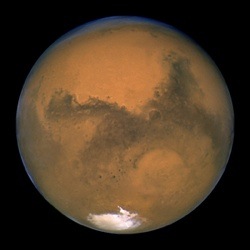Summary | Excerpt | Reading Guide | Reviews | Beyond the Book | Read-Alikes | Genres & Themes | Author Bio

Critics' Opinion:
Readers' Opinion:
First Published:
Feb 2014, 384 pages
Paperback:
Nov 2014, 384 pages
 Book Reviewed by:
Book Reviewed by:
Kim Kovacs
Buy This Book
This article relates to The Martian
 Andy Weir's The Martian is set on the red planet, the fourth from the sun, which has been part of human consciousness since people first started observing the night sky. Its distinctive red color sets it apart from the other celestial objects. The oldest known star map, found in the tomb of 18th dynasty Egyptian architect Senenmut (who lived around 1400 BC), includes a depiction of Mars. It's mentioned in Egyptian writing even earlier. Chinese astronomers documented its position and orbit before the founding of the Zhou Dynasty in 1045 BCE. Galileo was the first person to observe the planet through a telescope – doing so in the early 17th century.
Andy Weir's The Martian is set on the red planet, the fourth from the sun, which has been part of human consciousness since people first started observing the night sky. Its distinctive red color sets it apart from the other celestial objects. The oldest known star map, found in the tomb of 18th dynasty Egyptian architect Senenmut (who lived around 1400 BC), includes a depiction of Mars. It's mentioned in Egyptian writing even earlier. Chinese astronomers documented its position and orbit before the founding of the Zhou Dynasty in 1045 BCE. Galileo was the first person to observe the planet through a telescope – doing so in the early 17th century.
The planet we now call Mars has had many names over the centuries. The Egyptians initially referred to it as "Horus of the Horizon" and later as "Horus the Red." The Babylonians wrote about it in conjunction with Nergal, their god of fire, war and destruction (perhaps the first association of the planet with conflict). The Hebrews called it Ma'adim – "The One Who Blushes" (and from which the Ma'adim Vallis, the longest outflow channel
on Mars, takes its name). In ancient China, the rise of the "fire star" was an omen of impending violence. The Greeks, too, associated the planet with war, referring to it as Areos aster – "Star of Ares," and later the Romans appropriated the idea, calling it stella Martis – "Star of Mars" – in honor of their own war god.
Although Mars is the closest planet to Earth, the distance between the two varies considerably due to Mars's more elliptical orbit. In theory, the closest the two can come together is 33.9 million miles, but scientists calculate this hasn't occurred in over 50,000 years. In modern times, the closest recorded approach was in 2003, when the planets were approximately 35 million miles apart; they will also be relatively near each other again in 2018, separated by 35.8 million miles.
Mars has two moons, first observed by American astronomer Asaph Hall in 1877. He named them after the Greek god Ares's sons Phobus ("Fear") and Deimos ("Rout"). They're much smaller than the Earth's moons, and irregularly shaped; Phobos is only 17 miles across at its widest, and Deimos is a mere 9 miles in width.
The geology of Mars is fascinating. Its red color is due to the iron-rich minerals in its soil (it's literally rusting). It is home to the highest known mountain in the solar system: Olympus Mons, a volcano that is is 370 miles in diameter (large enough to cover the state of New Mexico). Mars also hosts the Valles Marineris, a system of canyons which runs as deep as six miles, stretches 125 miles wide in places, and has a length of over 2,500 miles.
So far, no life has been shown to have ever existed on the planet, although it remains a tantalizing possibility that scientists continue to investigate. Many obstacles would need to be overcome for Earth-like lifeforms to thrive there. There is no known liquid water on the surface of Mars (although there is frozen water at its poles and recent discoveries seem to indicate liquid water may exist seasonally on some parts of the planet). Also, the atmosphere is composed mostly of carbon dioxide with only 0.4% oxygen; the CO2 levels are high enough to be toxic to most plants. The atmospheric pressure is too low for humans to survive on the surface without protection, which would also be necessary to guard against the extreme ultra-violet radiation present. Nevertheless, plans for Mars exploration and colonization remain an active part of most of the world's space agencies. As of 2014, there have been nineteen successful missions launched by five different countries (US, Russia, China, Japan & India) plus the European Space Agency (an organization of 20 European countries).
Picture of Mars credit NASA/ESA
Filed under Nature and the Environment
![]() This "beyond the book article" relates to The Martian. It originally ran in March 2014 and has been updated for the
November 2014 paperback edition.
Go to magazine.
This "beyond the book article" relates to The Martian. It originally ran in March 2014 and has been updated for the
November 2014 paperback edition.
Go to magazine.





The Flower Sisters
by Michelle Collins Anderson
From the new Fannie Flagg of the Ozarks, a richly-woven story of family, forgiveness, and reinvention.

The House on Biscayne Bay
by Chanel Cleeton
As death stalks a gothic mansion in Miami, the lives of two women intertwine as the past and present collide.

The Funeral Cryer by Wenyan Lu
Debut novelist Wenyan Lu brings us this witty yet profound story about one woman's midlife reawakening in contemporary rural China.
Your guide toexceptional books
BookBrowse seeks out and recommends the best in contemporary fiction and nonfiction—books that not only engage and entertain but also deepen our understanding of ourselves and the world around us.